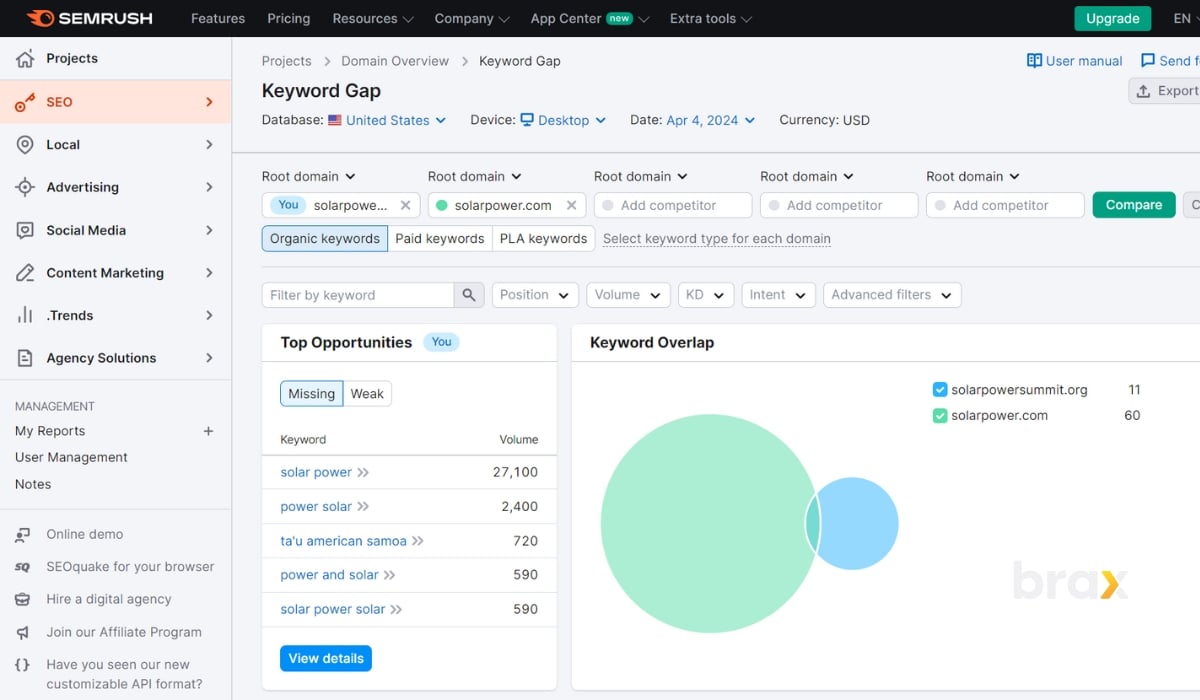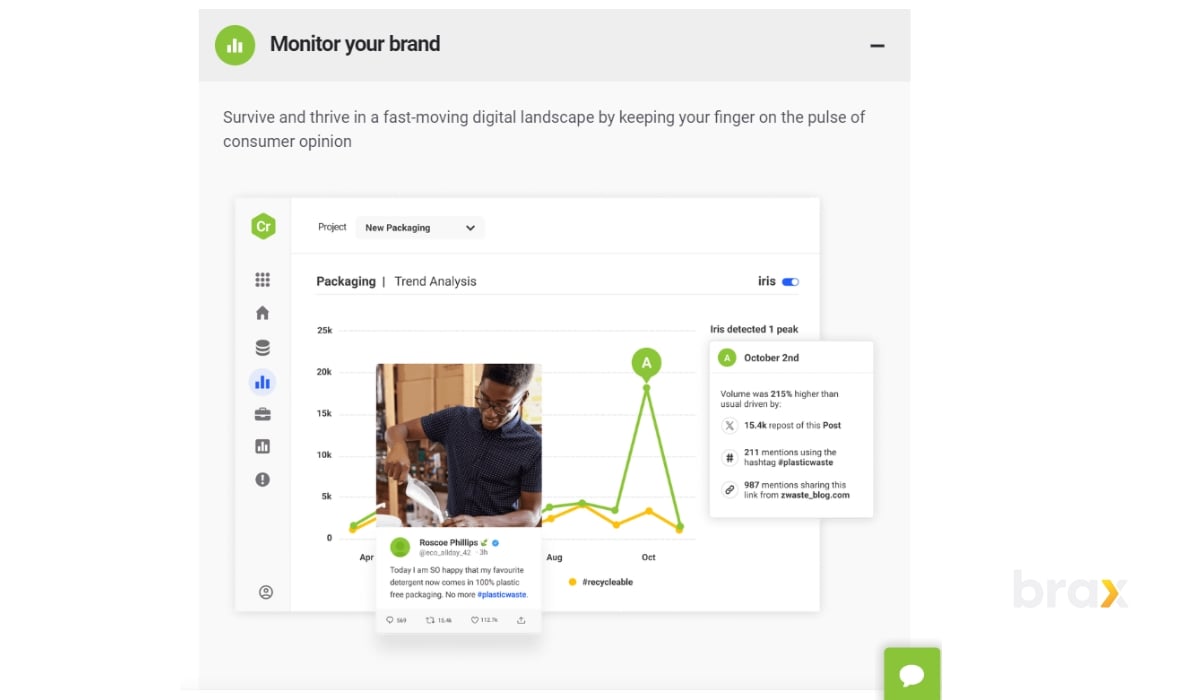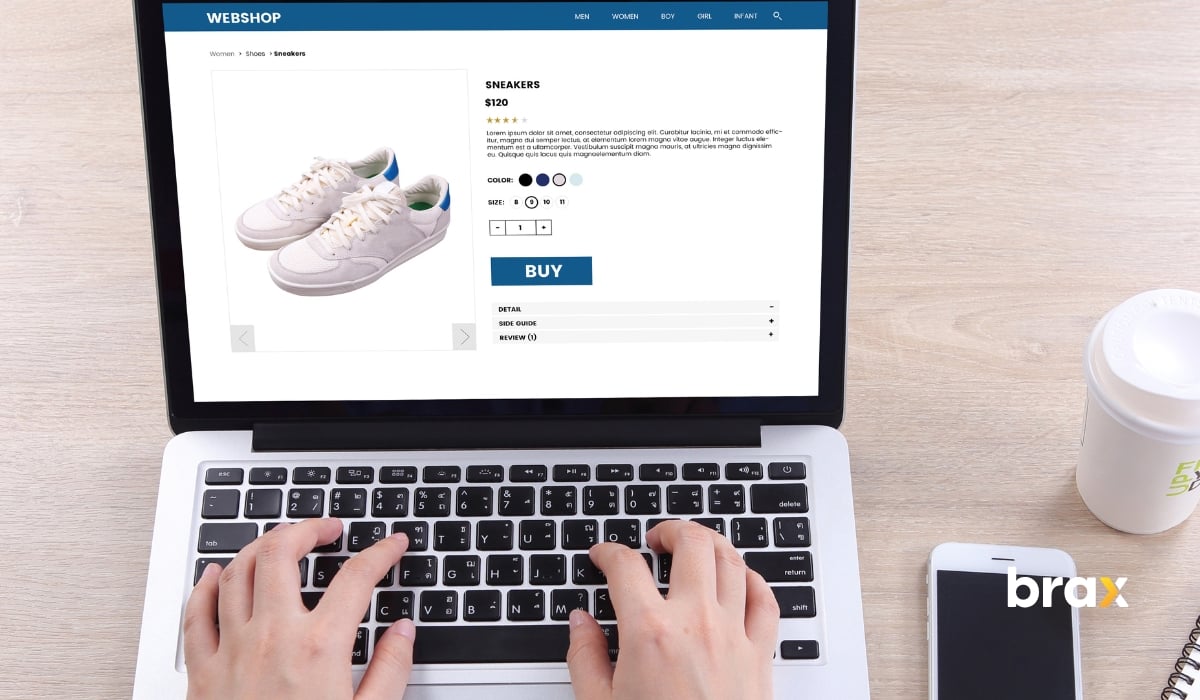Have you ever wondered why people search for certain things online? It's all about audience intent — the real reasons and goals driving those searches.
Whether it's to find a perfect recipe, the best laptop, or simply to learn something new, understanding this intent is key for anyone creating content or selling products online.
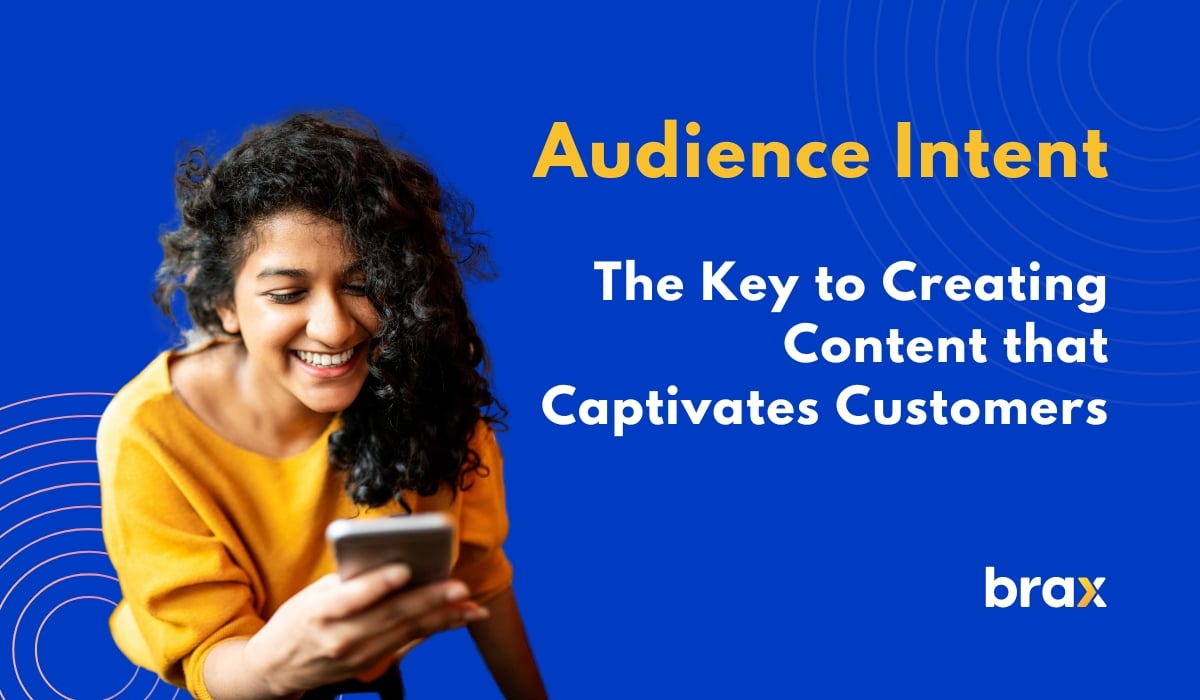
By getting into the minds of your audience and knowing what they really want, you can tailor your content to match their needs, making your stuff more engaging and boosting those all-important conversion rates.
The very first thing we need to do to learn about the user intent is to know your audience.
Why Know Your Audience?
Understanding your audience is key to making and sharing content that really hits the mark and gets results. Once you know who your audience is and what they're looking for, you can customize your content to deliver the most value.
Here are some key reasons why understanding your audience really matters:
Targeted Content Creation
Getting to know your audience lets you customize your message and whip up content that really speaks to what they're into (interests), what they need (needs), and what bothers them (pain points). This kind of fine-tuning means you'll likely see better engagement rates since the content comes across as more personalized and spot-on for the reader.
Imagine yourself being in their shoes and finding exactly what you want in a website you visit. You'll feel happy and thankful you found what you need, right?

Increased Engagement
When an audience feels that the content speaks directly to them, they're more likely to engage with it through likes, shares, comments, and reading more related content on your website.
This heightened engagement not only boosts the performance of the content but also strengthens the relationship between the brand and its audience. Engaging more with the content is the user's way of thanking you for your help.
If you're earning from ad arbitration, this means higher earnings per user or ad click. In short, better ROAS!
Improved Conversion Rates
Understanding your audience means you can create calls to action that really resonate with them. Getting this right boosts your chances of guiding them through the sales funnel and cranking up those conversion rates.
Read More: Warm Up Your Customers With Marketing Funnels
Customer Retention
By consistently meeting the needs and expectations of your audience with your content, you reinforce their loyalty to your brand or website. A deep understanding of your audience can lead to higher customer retention rates as your content continues to meet their evolving needs.
When they like you, they may even bookmark your site for future reading. This means return customers at zero cost!
Cost-Effective Marketing
Zeroing in on your audience with pinpoint accuracy means you're not just throwing resources out there; you're investing them wisely for a bigger payoff.
Your marketing game becomes more cost-effective as you're directly speaking to folks who genuinely care about what you have to say.
How to Identify Your Audience for the Purpose of Audience Intent
By pinpointing exactly who your content is for, you can ensure that every piece of content you produce is both relevant and impactful. But how exactly can you do that?
Here are the ways:
Create Audience Personas
Creating audience personas is a strategic approach to understanding and segmenting your audience based on shared characteristics.
Audience personas represent idealized groups of users who exhibit similar behaviors, goals, and motivations in their search and consumption of online content.
By honing in on these, marketers and content creators get a clear picture of what their target audience likes and struggles with. This is super helpful for making sure their content really speaks to what their audience wants.

Key Steps in Developing Audience Personas
1. Research
Collect demographic and psychographic data, along with insights into online behavior patterns, from your existing audience. Utilize surveys, interviews, and analytics tools to gather this information.
2. Segmentation
Analyze the data to identify commonalities that might suggest different personas within your audience. Look for trends in how different groups access, engage with, and respond to your content.
3. Persona Profiles
Develop detailed persona profiles that include names, job roles, and personal backgrounds. The profiles should also describe the challenges and objectives that each persona faces, which inform their intent when interacting with your content.
4. Application
Apply these personas to the content creation process by considering the intent of each persona. Create content that addresses their specific needs, solves their problems, and answers their questions.
5. Refinement
Regularly assess and refine personas as the audience evolves and new data becomes available, ensuring ongoing alignment with audience intent.
For more in-depth understanding on how this can be done, have a look at this article: How to Build the Perfect Targeting Persona
Researching the Market for Audience Intent
Conducting market research is a fundamental step in gaining insights into your audience's preferences, behaviors, and decision-making processes.
By using stuff like focus groups, interviews, and checking out consumer data, companies can grab heaps of useful info that helps them get a better grip on what their audience is looking for.
While this may sound too technical, it's not really that hard. Let's talk about how you can do this and what tools you can utilize:
1. Identifying Trends
Market research helps in spotting current trends that are influencing your audience's choices and perceptions. These trends can offer cues about the shifting priorities and intents of your audience.
Here are some key tools that can illuminate these insights:
Google Keyword Planner
A fundamental tool for any digital strategist, Google Keyword Planner allows users to discover keywords related to their business and see estimates of the searches they receive. This can be instrumental in understanding what your audience is looking for.
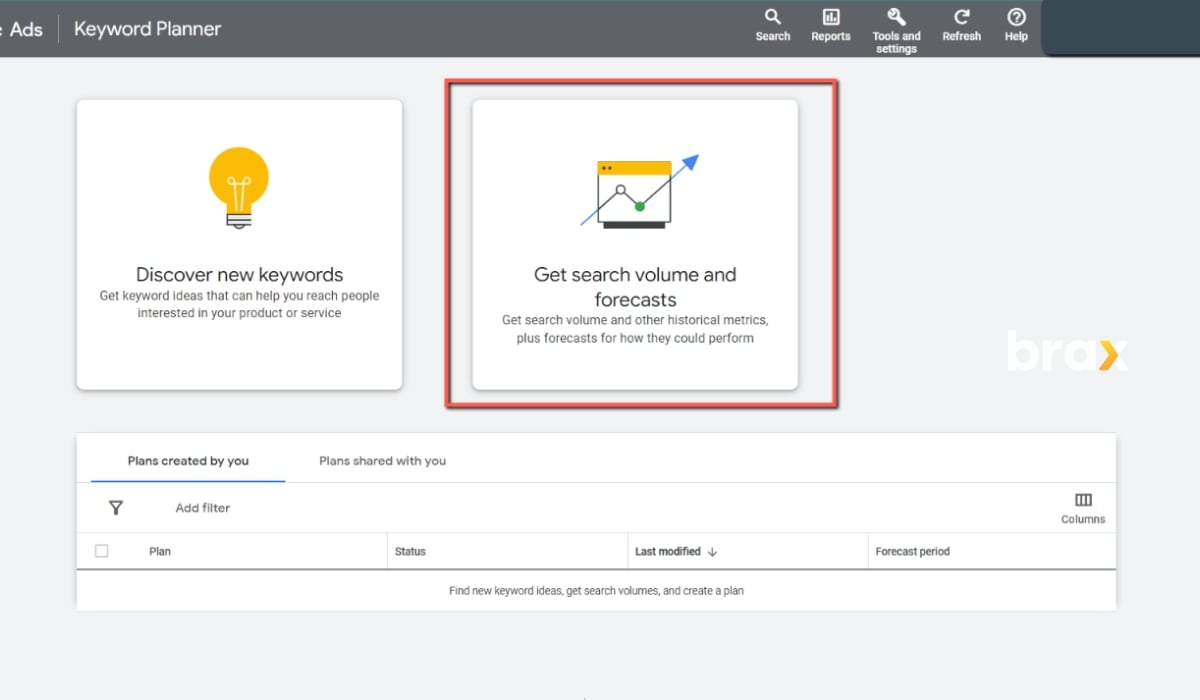
Google Trends
This is an easy tool to use for this purpose. Just enter the keywords of your main topic in the Google Trends page, choose the location, date range, and category, and you'll be provided with relevant terms.
AnswerThePublic
By visualizing search questions and providing instantly useful data to content creators, AnswerThePublic helps in uncovering the exact phrases people use in their searches.
This is invaluable for creating content that fulfills informational intent.
2. User Feedback
Gathering direct feedback from visitors gives you raw data on their experiences, needs, and expectations, which shape their intent when interacting with your brand and content.
Simple customer feedback tools such as placing a thumbs up or thumbs down button at the end of every article will let you know what your readers think.
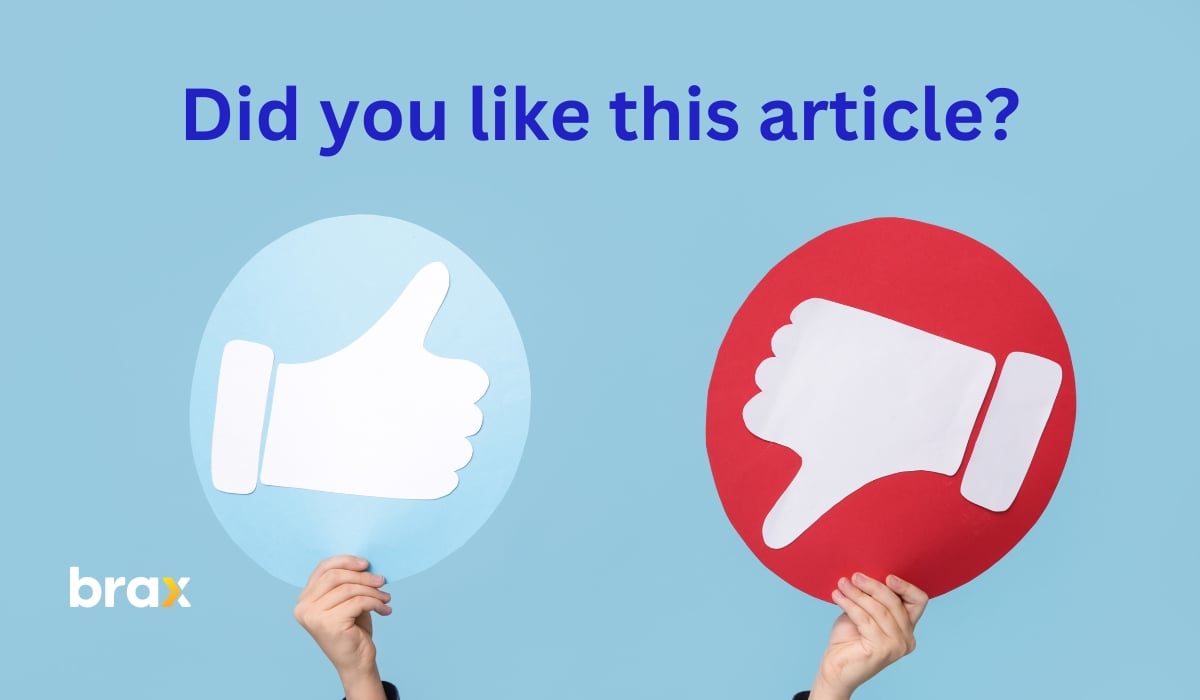
But if you'd like to utilize some tools, here's what you can use:
SurveyMonkey
Whip up a survey in no time. It’s a piece of cake to use and can reach your audience wherever they hang out online.
It lets you ask all sorts of questions to really understand what’s ticking in the minds of your audience.
Google Forms
This one’s a freebie and super easy to use. You can quickly create surveys or feedback forms and get responses straight to your inbox using Google Forms.
This is perfect for getting a pulse on what your audience loves or wants more of, plus it's super simple to set up and share.
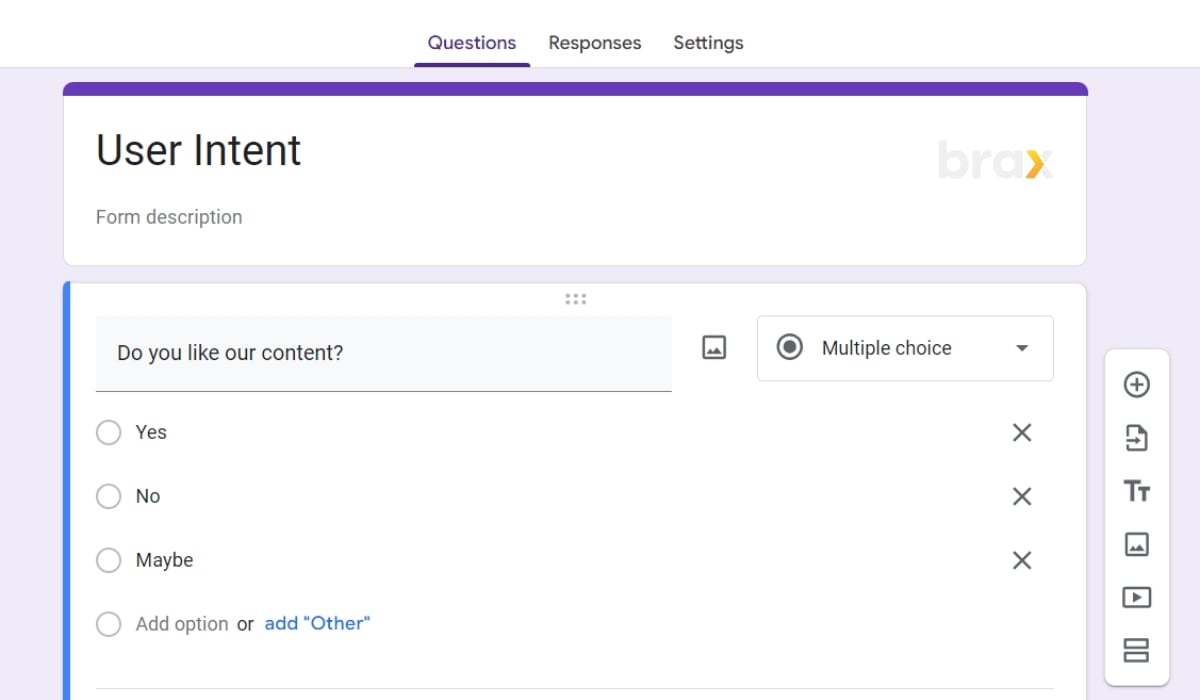
Typeform
Fancy and fun to fill out, Typeform takes surveys to the next level. It’s all about making the experience breezy for users, so they’re more likely to give you those golden nuggets of feedback.
Its cheapest plan is priced at $25 per month.
These tools aren’t just about asking questions; they’re about listening.
By paying attention to what your audience shares, you can learn loads. What content are they vibing with? What do they wish you’d cover?
Responses can help you spot trends, tweak your content, and zero in on what makes your users tick. And who knows? They might just clue you into their next big need or idea.
3. Competitive Analysis
Watching what your competitors do and how they connect with similar audiences can give you a sneak peek into what makes your niche tick, revealing opportunities or gaps you can take advantage of.
SEMrush
This comprehensive suite offers an in-depth look at your competitive landscape, including the keywords your competitors are ranking for. SEMrush helps in refining your content strategy to align with audience intent by revealing gap opportunities.
Ahrefs
Known for its backlink and SEO analysis tools, Ahrefs also provides features for keyword research, including search volume, keyword difficulty, and the ranking of top pages. This can assist in crafting content that matches what users are actively seeking.
Moz Keyword Explorer
Moz offers a user-friendly interface to explore keyword suggestions, search volume data, and SERP analysis. Utilizing this tool can help in identifying trending topics and questions your audience is asking.
4. Behavioral Analysis
Looking at real behaviors, like what people buy and how they interact on your website, can show us what's really driving buying motivations and customer actions. Digging into this can give us a deeper, data-backed insight into what our audience is all about.
Heat maps visually display where users are clicking and scrolling on a page, giving insight into which elements of your content are capturing the most attention and driving engagement.
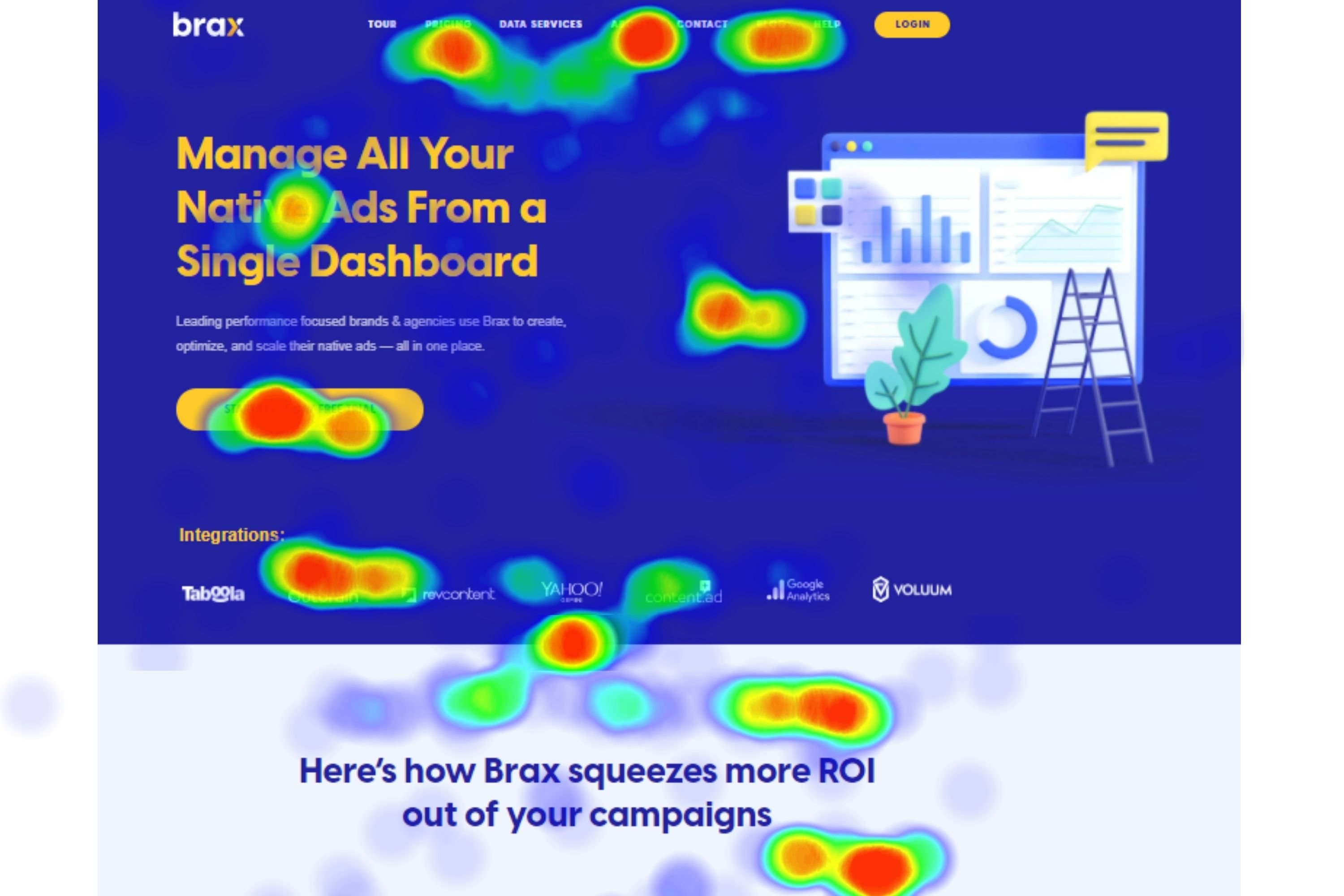
Incorporating heatmaps offers a visual insight into user interactions on a website, crucial for understanding behavior patterns. Tools like Hotjar and Crazy Egg play a pivotal role here:
Hotjar
Hotjar reveals where users click, tap, and scroll, highlighting the parts of your site that capture the most attention. It's essential for identifying what attracts users and keeping them engaged.
Crazy Egg
This tool provides a heatmap of user activity, offering clear clues about where visitors are focusing on your webpage. Crazy Egg can help in tweaking both content and design to better meet user expectations.
5. Social Listening
Social media listening tools are indispensable for tracking real-time discussions and sentiments regarding brands and specific topics.
Here are some examples of such tools and how they function:
Hootsuite
Hootsuite monitors social media platforms for brand mentions, comments, and hashtags, offering a comprehensive view of public opinion. It's a powerful way to understand what's resonating with your audience.
Brandwatch
As its name implies, Brandwatch gets right into the heart of social media conversations on a specific brand, helping marketers spot patterns, trends, and what people really think about their brand. It's super handy for spotting changes in what the public's into or worried about.
Sprout Social
By capturing mentions and interactions across social platforms, Sprout Social aids businesses in pinpointing user intent—whether it's interest in a product or seeking customer support.
Using these tools helps marketers get a real feel for what their audience is into, tweaking content to better suit current interests and needs.
Utilizing Your Own Analytics for Audience Insight
Using analytics is a great way to get insights into your audience without having to ask them. Instead, you can look into how they act on or off your website.
Data analytics tools offer a comprehensive overview of user behavior and event intent data.
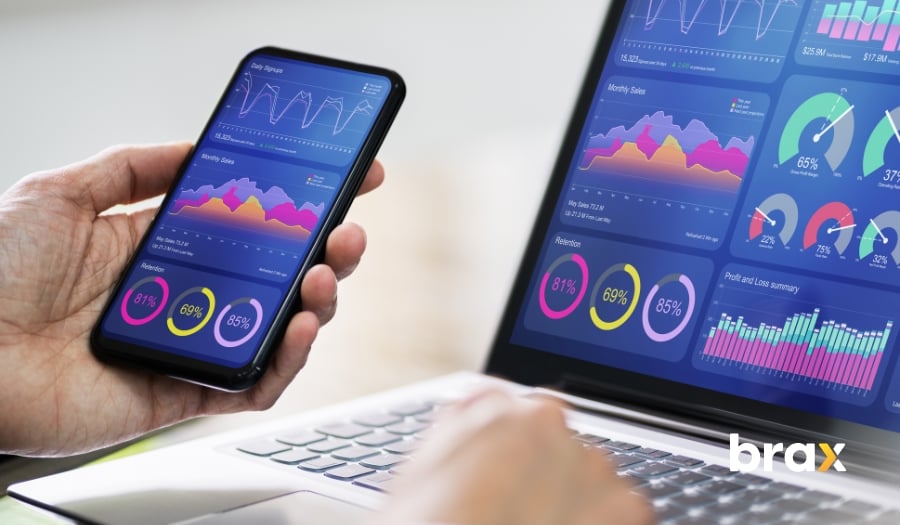
Here are some of the metrics you can monitor with your analytics tools:
Traffic Sources
Understanding where your audience comes from (search engines, social media, referrals, or direct visits) can indicate their interest levels and the intent behind their visits.
When you know the sources that perform well, you can allocate not just your time but your advertising budget (whether using social media or native ads) to these sources.
Engagement Metrics
Tracking engagement with stuff like page views, bounce rates, and how long people stick around gives you a hint about how much your audience digs your content and if it's what they're really looking for.
Conversion Tracking
Analytics can track conversions and pinpoint which content leads to desired actions, reflecting the intent of your audience to engage further or make a purchase.
Content Performance
Examining which pieces of content perform the best helps reveal topics and formats that align with your audience's intent, enabling you to optimize your content strategy accordingly.
User Flow
Analyzing the paths visitors take through your website can shed light on their intent, showing which content is most effective in guiding them through the customer journey.
By weaving these analytics-driven insights into your content strategy, you can tweak your offerings to match the audience intent. If the data points out that folks are digging a specific type of content or topic, that's a solid hint on what to focus on for future content.
For instance, if users frequently visit "how-to" guides or tutorials, creating more instructional content could satisfy this intent and boost engagement.
Effective use of analytics closes the loop between audience personas, market research, and real-time user behavior, leading to content that is not only engaging but also intent-driven and user-centric.
Different Types of User Intent and Content that Works Best for Each
Now that we know your target audience, let's look into the type of intent they have when visiting your site. Understanding the different types of audience intent is crucial for creating content that precisely caters to your audience's needs.
Is your visitor here to buy something, learn, get entertained, or find a solution to a problem? Are they visiting with informational or transactional intent? Knowing this lets you whip up a strategy that meets their expectations spot on.
Let's explore the various forms of audience intent and how they can influence content creation and distribution.
Informational Intent
When users approach content with informational intent, they are primarily seeking knowledge, answers, or data.
They might be in the early stages of research or simply looking to satisfy curiosity about a particular topic. This type of intent is not immediately transactional, but it may lead to further engagement if the informational needs are met effectively.

How do you identify informational intent based on search queries?
Their search queries typically include questions starting with "who," "what," "where," "when," "why," or "how." These terms signify a quest for information rather than an immediate intent to buy.
Informational Intent Content
Articles, blog posts, how-to guides, FAQs, and tutorials are typical formats that serve users with informational intent, providing them with the knowledge they are searching for.
To fulfill information-seeking behavior, the content must be authoritative and thoroughly researched, positioning your brand as a trustworthy source. You must prove to the audience that you are an expert in the field.
SEO Best Practices for Informational Audiences
Optimizing relevant content for informational intent means deliberately incorporating relevant keywords that potential readers might use when searching for information on a topic.
It also involves structuring the content with clear, descriptive headings that guide readers through the material, making it easier for them to find the specific information they're seeking.
Additionally, providing in-depth explanations that cover the topic comprehensively is crucial.
This approach ensures that the content not only meets the audience's informational intent but also positions it as a reliable and authoritative source on the subject matter.
When users seek knowledge, providing them with informative blog posts, how-to guides, and FAQs can satisfy their curiosities and establish a foundation of trust.
It's essential to anticipate questions and deliver clear, concise, and useful information. This kind of information works best for search and ad arbitrage businesses as this type of content encourages users to say and read more.
Navigational Intent
Navigational intent reflects the user's desire to locate a specific website or page within a website. Typically, this occurs when the user already has a particular brand or service in mind and is seeking to engage with it directly.
Unlike informational intent, where users are in the exploration phase, navigational intent is centered around familiarity and purpose.

How do we identify navigational intent based on search queries?
Users with navigational intent often use specific brand names or website titles in their queries.
For example, someone typing "Brax pricing" or "YouTube trending" is looking for a particular page within these well-known sites.
How do we engage such users?
Ensuring that users are immediately directed to the correct page they are seeking improves user experience. This can be achieved through a well-structured site hierarchy and clear internal linking.
Best Practices for Audiences with Navigational Intent
It is essential to optimize the site for branded keywords to ensure that when users search for the brand, the official site appears at the top of the search results.
On top of that, a clear and intuitive navigation bar, site map, and search function can significantly enhance the navigational experiences for visitors. This will allow them to find the desired content with minimal effort.
An intuitive site menu and a robust internal linking structure help users find what they need quickly.
Creating clear categories, implementing search-friendly URL structures, and incorporating breadcrumb navigation also aid in fulfilling navigational intent, so make sure you apply those if you are focusing on navigational intent audiences.
Commercial Investigation Intent
Commercial investigation is all about doing your homework before you decide to buy something or commit to it.
Imagine you're in the market for a new gadget, service, or maybe even a vacation plan. You're not just going to jump in without looking around, right?
This is the phase where you're really thinking things over, comparing different options, diving into reviews, and checking out what everyone else thinks.
It's like gathering all the pieces of the puzzle to see which one fits your needs the best.
You're in the consideration phase of your shopping journey, trying to make sense of all the options out there to snag the deal that feels just right for you.

How do we identify commercial investigation intent based on search queries?
When users are engaged in commercial research, they frequently perform searches that compare different options. These comparative queries, often formatted as "X vs Y", are aimed at uncovering both the differences and similarities between products or services.
This approach allows users to gain a comprehensive understanding of what each option offers, assisting them in making informed decisions based on their specific needs and preferences.
By evaluating the attributes of each choice side by side, users can more easily identify which product or service best aligns with their needs.
Commercial Investigation Intent Content
In-Depth Reviews and Testimonials
In this vital phase, offering comprehensive and detailed reviews alongside genuine user testimonials becomes indispensable. These elements provide deep insights into real-world applications and performance, directly impacting the user's decision-making process.
By showcasing experiences from existing users, potential customers gain a clearer understanding of how the product really works from the point of view of someone who used them, guiding them toward making an informed final decision.
Expert Opinions
When it comes to making decisions, websites offering detailed reviews and insights from industry experts really make a difference. People looking for professional advice and recommendations highly value these expert opinions.
The credibility and authority of these experts add serious weight to their reviews, nudging users to go for products that get a thumbs-up from the pros in the biz.
Feature Breakdowns
Providing detailed lists that meticulously dissect and highlight the key features and benefits of a product can play a pivotal role in the user's evaluation process.
These breakdowns assist users in comparing and contrasting available options, emphasizing the unique selling points and advantages of each product.
By clearly outlining what sets a product apart, users can easily differentiate between choices, facilitating a more straightforward and informed selection process.
Pros and Cons
Along with feature breakdowns, highlighting the pros and cons of products can also aid users in their decision-making process. By presenting an honest assessment of both the benefits and drawbacks of a product, potential customers gain a more balanced view of what to expect.
This promotes transparency and trust, which are vital elements for commercial investigation intent. It also makes it easier for users to decide, so you can use these to lead the reader to your intended decision.
Transactional Intent
Transactional intent is when a user is ready to take action, typically in the form of a purchase, but it can also relate to any interaction they wish to complete, such as signing up for a newsletter or registering for a webinar.
This audience has moved beyond the informational and navigational stages and is at the point of conversion.
How do we identify transactional intent based on search queries?
Audiences that are in the "transaction mode" typically use what we call Conversion-Driven Queries.
These often include specific product names or services combined with words like "buy," "deal," "coupon," or "price." Such terms signal a user's readiness to engage in a financial transaction.
Transactional Intent Content
High-conversion landing pages and compelling calls-to-action (CTAs) are valuable informational intent content.
Clear, benefit-oriented buttons like "Buy Now," "Get 50% Off," or "Book Appointment" align with the user’s intent to make an immediate transaction.
Recommended Reading: Increase Conversions with the Best Call to Action (Samples Included!)
Best Practices for Audiences with Transactional Intent
To maximize conversions, it's crucial that the purchasing or signup process is designed to be as seamless as possible.
This means reducing the number of steps required to complete a transaction to the bare minimum, thereby avoiding potential cart abandonment or a loss of interest from potential customers.
Streamlining this process not only enhances the user experience but also significantly increases the likelihood of converting visitors into paying customers or registered users.
Don't forget to add Trust Signals too. Things like trust badges, secure payment options, customer testimonials, and straightforward return policies can really boost trust. This is super important for users getting ready to make a transaction.
Users who are ready to buy require content with a clear path to purchase, such as product descriptions that highlight unique selling points, customer testimonials, and prominent CTAs.
Ensuring the content directly addresses the aspects of a product or service that are most relevant to purchase decisions will cater to transactional intent audiences and lead them to become actual customers.
User Intent + Matching Content = Achieving Goals!
Matching your content with user intent is the key to achieving the primary goals of your website, whether it be to retain visitors on your site longer to expose them to ads, encourage them to subscribe to your services, or drive them toward making a purchase.
Aligning your content with user intent isn't just about matching keywords; it's a multifaceted strategy that includes continuously understanding and adapting to audience intent and fostering a culture of responsiveness to audience needs.
This smart move makes sure every piece of content has its own role, helping to achieve your website's and business's big-picture objectives.
If you're experiencing challenges in aligning your content with your business goals and the user intent, Brax's expert marketing team is here to assist.
Reach out to us and let's discuss how we can help you tailor your content strategy to meet both your audience's needs and your business objectives. Together, we can create content that not only captivates your audience but also drives your business forward.
